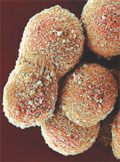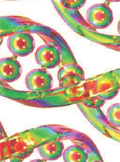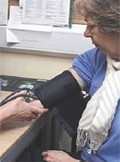The eLitMed.hu medical portal uses computer cookies for convenient operation. Detailed information can be found in the Cookie-policy.
Lege Artis Medicinae - 2012;22(05)
Content
[Liver diseases and diabetes mellitus]
[The liver plays a pivotal role in metabolism. Thus, it is hardly surprising that its acute and chronic diseases may be accompanied by multiple disturbances of the carbohydrate metabolism, and the development of diabetes mellitus - primarily of type 2 diabetes mellitus - may result in structural changes in the liver. This article overviews the main pathogenetic mechanisms of this bidirectional relationship, discusses special considerations of choosing the therapy and highlights special difficulties of the assessment of a diabetic metabolism.]
[The role of vitamin D in gastrointestinal diseases]
[The amount of the fat-soluble vitamin D can be reduced by a number of chronic diseases or even obesity. On the other hand, vitamin D itself can also influence the development or course of these disorders. Some gastrointestinal diseases are known to cause vitamin D deficiency, but some observations and studies have also proved that certain gastrointestinal diseases occur more frequently in case of vitamin D deficiency. Moreover, in case of some intestinal tumours even “vitamin D sensitivity” can occur. Our aim is to introduce the relationship between vitamin D and gastrointestinal diseases, and to highlight the importance of vitamin D replacement in gastrointestinal diseases accompanied by vitamin D deficiency or vitamin D sensitivity.]
[Prevention and treatment of hepatic encephalopathy]
[As acute or chronic liver diseases progress, liver failure and related hepatic encephalopathy may develop. The latter occurs in more than 70% of patients with hepatic cirrhosis. Because of declining cognitive functions, sleep disturbances, memory problems and impaired motion coordination, this condition can - even in mild form - limit the patient's self-sufficiency and activity and can lead to a decreased quality of life and ability to work. Its most advanced stage, hepatic coma is one of the leading causes of liver-related mortality. These conditions generate a substantial healthcare costs. Treatment of hepatic encephalopathy involves dietary restrictions, prevention and treatment of precipitating factors, inhibition of the production and absorption of toxic substances (especially ammonia) and restoration of the amino acid balance. In addition to the traditionally used treatment with disaccharids (lactulose, lactitol), evidence has been accumulating regarding the efficacy and safety of a nonabsorbable antibiotic compound, rifaximin, which targets enteral pathogen bacteria, both in treatment and in prevention of hepatic encephalopathy. Artificial liver support therapies have been also introduced in Hungary. This review summarises the experience regarding treatment of hepatic encephalography for physicians involved in the management of patients with hepatic diseases.]
[Insulin dose titration in type 1 diabetes mellitus: A blessing or a curse?]
[INTRODUCTION - Knowing the pharmacokinetic properties of different insulins, useful treatment algorithms can be set up for the majority of our insulin-treated patients. When planning either a human or an analogue basal-bolus regimen, the first task is to determine the daily insulin requirement, followed by determination of the optimal rate of basal and bolus insulins. CASE REPORT - In a 33-year old, moderately obese man with type 1 diabetes who received 180 U daily insulin doses, accumulated hypoglycaemic episodes with neuroglycopenic symptoms occured. After cessation of the original insulin therapy and starting an analogue basal-bolus treatment regimen, both the carbohydrate metabolism and the overall quality of life of the patient have significantly improved. Optimal metabolic control was achieved by a basal insulin ratio above 50%. CONCLUSION - Using elements of the analogue basal-bolus regimen - one of the state-of-the-art forms of insulin treatment - at the appropriate dose and dose ratio, it is possible to comply with the therapeutic requirements of our age. However, if this weapon is used inappropriately, it might actually harm patients.]
[Asserting basis-bolus principle by analogue insulin preparations in pre-pubertal child with diabetes]
[INTRODUCTION - The choice of insulin combination therapy in children with type 1 diabetes mellitus is determined basically by the diet as well as the age of the patient. However, life rhythms of individual children are widely different. As a consequence, insulin therapy must be tailored to individual needs, by chosing the optimal one from the available insulin products with different efficacy curves. The aim is, of course, to maintain near-normoglycaemia for years or decades. CASE STUDY - The author presents the case of a 10-year-old girl with diabetes for 4 years, whose insulin treatment has involved a number of combinations. Good metabolic balance could be obtained by premixed insulin preparations for more than two years. However, subsequent intensive treatment with human insulins had poor results. This was primarily due to the fact that the child had a rather hectic daily schedule and eating habits, although she ate - appropriately for her age - six meals per day. After changing the ratios of the meals while maintaining her six-mealsper- day regime, an analogue glargine/glulisine combination therapy was induced, with a significant increase in the basal/ bolus ratio. This treatment was successful: HbA1c level got to the target range, without changes - theoretically caused by the rapid analogue - in hypo- and hyperglycaemic periods before and after small meals, respectively. CONCLUSION - During the time of remission, treatment with premixed human insulin can maintain good metabolic balance even for years, while saving (at least) two pricks per day. Insulin treatment intensified by analogue insulins (glulisine/glargine) may be attempted in prepubertal children needing six meals a day, provided their lifestyle raises problems. Glargine, given in an increased ratio, can compensate the hyperglycaemic effect of minimised small meals.]
1.
Clinical Neuroscience
Is there any difference in mortality rates of atrial fibrillation detected before or after ischemic stroke?2.
Clinical Neuroscience
Factors influencing the level of stigma in Parkinson’s disease in western Turkey3.
Clinical Neuroscience
Neuropathic pain and mood disorders in earthquake survivors with peripheral nerve injuries4.
Journal of Nursing Theory and Practice
[Correlations of Sarcopenia, Frailty, Falls and Social Isolation – A Literature Review in the Light of Swedish Statistics]5.
Clinical Neuroscience
[Comparison of pain intensity measurements among patients with low-back pain]1.
Clinical Neuroscience Proceedings
[A Magyar Stroke Társaság XVIII. Kongresszusa és a Magyar Neuroszonológiai Társaság XV. Konferenciája. Absztraktfüzet]2.
3.
Journal of Nursing Theory and Practice
[A selection of the entries submitted to the literary contest "Honorable mission: the joys and challenges of our profession" ]4.
Journal of Nursing Theory and Practice
[End of Life and Palliative Care of Newborns in the Nursing Context]5.
Journal of Nursing Theory and Practice
[Aspects of Occupational Health Nursing for Incurable Patients ]


















